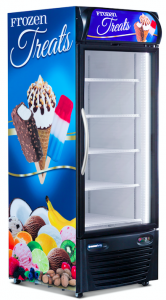Refrigeration cleaning tips to protect against COVID-19 and food-borne bacteria
With convenience stores and micro markets declared essential services during the COVID-19 pandemic, your site likely adopted a stricter cleaning routine to prevent the virus spread. This is also an ideal time to look at best practices for food safety, because commercial refrigerators and freezers can quickly become bacterial carriers if not properly maintained.
Given the right conditions, bacteria found in food can double every 10 minutes, which means that 1,000 bacteria can grow to 1/2 million about 90 minutes! So, let’s look at how to create conditions where neither COVID-19 or food-borne bacteria can survive.
Cleaning 101
Research shows COVID-19 can survive up to nine days onmetal, glass and plastic if these surfaces are not properly disinfected. While it can be tempting to saturate your refrigerated units with a strong cleaner like bleach or ammonia, don’t, as these products can contaminate food.
Instead, use a soft cloth with a non-abrasive liquid detergent cleaner mixed with water. Soap and water are proven to eliminate the virus, as soap interferes with the fats in the virus shell, which lifts the virus from surfaces and is then rinsed off with water. (This is also why frequent handwashing is effective at preventing the virus spread.)
We recommend deep cleaning your refrigeration units monthly, but exterior door handles and doors are high-traffic areas and should be wiped down several times a day. While most sites these days have hand sanitizer available for customers to use at the checkout counter, it’s also a good idea to provide hand sanitizer or sanitizing hand wipes (with at least 70% alcohol content) directly beside any refrigerated merchandisers.
Before deep cleaning your unit’s interior or exterior, always unplug it. Neverapply or spray any undiluted cleaner directly to the unit, since excessive liquid can seep into the electrical connections and cause a malfunction or electrical hazard. To avoid any contamination, ensure all cleaning materials are cleaned themselves (for instance, use a fresh cloth each time) and stored so bacteria is not transferred from one surface to another. Also, keep cleaning equipment for refrigeration units separate from those used for floors or other store equipment.
Cleaning also gives you a chance to inspect the unit for any damage. For example, when wiping down the door gaskets and glass, check for gaps or tears in the gaskets, which can cause air leakage or a build-up of dirt or grease. If you’re not able to snap them back into place, they need to be replaced. Most units are self-defrosting, but if you have manual defrost units, follow the manufacturer’s instructions—regular defrosting is essential, as it helps prevent serious damage to compressors.
If your unit has a conventional condenser, it should also be cleaned monthly to avoid breakdowns caused by an overworked motor. To clean it, remove the front grill, switch off on the control panel and unplug it, then use a small, hand-held duster to clean inside, and, if necessary, a vacuum cleaner for any additional debris. Don’t forget to reattach the front grill, which helps to protect the condenser from debris and damage.Some units are built with low maintenance condensers, which require regular visual inspections and much less frequent cleaning than conventional condensers.
Freezers need to breath

Without optimal airflow, you risk a blocked condenser, which can result in equipment failure, overheating, spoiled product, higher electrical costs and even a possible void on your warranty.
- Position each unit away from the surrounding walls
- Ensure each unit has a dedicated electrical outlet
- Situate away from other equipment that radiates heat or produces airborne oil and grime
- Inspect regularly to check for blockages
In addition, distribute the product evenly inside the unit, as overloading blocks interior airflow, which can lead to spoiled food and equipment damage. Cabinets are also better able to maintain a stable temperature if they’re stocked, but not overstocked, versus empty, as the thermal mass of the refrigerated or frozen products helps to maintain the interior temperature.
Temperature matters
Technically, a refrigeration unit can’t get a “fever”, but temperature variations are a serious threat to food safety, potentially contributing to bacteria growth, pathogens and cross-contamination.
In an environment where doors are being opened and closed frequently, maintaining optimal temperatures within the unit is crucial. For example, chilled foods, such as sandwiches should be kept within the 37°F to 41°F range. Short spikes, not exceeding 30 minutes, above 41°F are acceptable.
If you do not have a temperature malfunctioning safeguard, you should aim to monitor temperatures frequently each hour to make sure they are within the healthy range. Since you need to sanitize the handles on merchandiser doors often, you can do both cleaning and temperature monitoring tasks at once.
Randy Skyba is the vice-president of sales and marketing at Minus Forty Technologies in Georgetown, Ont. He helps retailers merchandise their frozen and refrigerated products.

